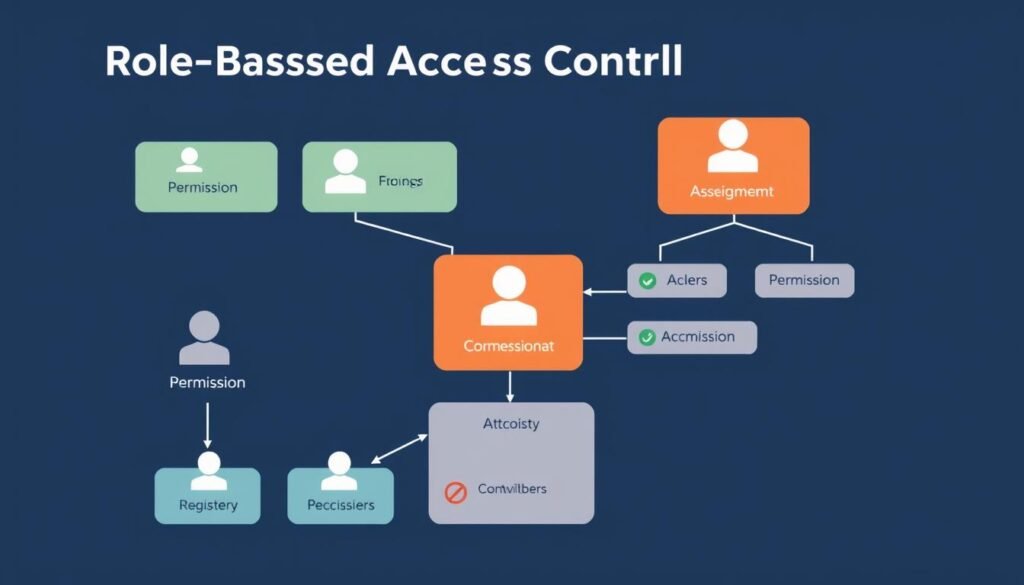In today’s unforgiving cybersecurity landscape, organizations that fail to implement proper access controls are practically inviting attackers in through the front door!
The principle of least privilege is an information security concept that gives users the minimum level of access necessary to complete their job responsibilities. CISA recommends using least privilege as a cybersecurity best practice.
Most organizations are shockingly unaware of the number of privileged credentials existing in their environments. Without visibility, security is merely an illusion. The principle of least privilege isn’t just another security buzzword; it’s the fundamental building block that separates secure organizations from those waiting to be breached.
Key Takeaways
- The principle of least privilege is crucial for minimizing security risks.
- Excessive user privileges are a significant contributor to data breaches.
- Effective user access management is key to preventing privilege creep.
- CISA recommends least privilege as a cybersecurity best practice.
- Organizations must have visibility into privileged credentials to ensure security.
- Implementing least privilege access is non-negotiable for modern organizations.
Understanding the Principle of Least Privilege
At its core, the principle of least privilege is about granting users the bare minimum access required to do their jobs, and nothing more! This concept is deceptively simple yet profoundly impactful on the security posture of an organization.
Definition and Core Concepts
The principle of least privilege (PoLP) is a minimum access policy that centrally manages and secures privileged credentials. It ensures that users have only the least amount of required privileges to perform their job functions. This approach is crucial in minimizing the damage that can be caused by a mistake or malicious intent.
The core idea is to shift from an “access by default” philosophy to “restriction by default” with exceptions only when necessary. As Jeremiah Grossman, a well-known security expert, once said, “The biggest risk is not the technology itself, but how we use it.” Implementing least privilege effectively requires a deep understanding of user roles and the resources they need to access.
“The principle of least privilege is not just a security best practice; it’s a necessity in today’s threat landscape.”
The Relationship Between Least Privilege and IAM
Identity and Access Management (IAM) serves as the critical infrastructure that enables least privilege implementation. Without robust IAM, least privilege remains just a theoretical concept. The relationship between IAM and least privilege is symbiotic: IAM provides the technical framework, while least privilege provides the governance principles.
| IAM Components | Least Privilege Implementation |
|---|---|
| Authentication | Verifying user identities before granting access |
| Authorization | Granting users the minimum access rights necessary |
| Audit and Compliance | Monitoring and reporting on user access and privileges |
By understanding and implementing the principle of least privilege, organizations can significantly enhance their security posture. As the threat landscape continues to evolve, adopting least privilege is not just a best practice; it’s a necessity.

The Growing Threat Landscape: Why Least Privilege Matters Now
The cyber threat landscape is becoming increasingly complex, with attackers now specifically targeting privileged credentials as their primary entry point! This shift in attack methodology has made it imperative for organizations to reevaluate their access management strategies.
Cyber Threat Evolution and Privileged Access
The evolution of cyber threats has been dramatic, with attackers moving from brute force methods to sophisticated social engineering tactics designed to compromise privileged accounts. Modern threat actors are patient and methodical, exploiting excessive privileges to move laterally through an organization’s environment, establishing persistence before launching their attack.

The Cost of Excessive Privileges: Breach Examples
The General Electric breach is a stark reminder of the dangers of ignoring least privilege. An engineer with excessive access stole over 8,000 sensitive files containing trade secrets, a breach that remained undetected for over eight years! This incident highlights the risk associated with excessive privileges and the potential security benefits of implementing least privilege access.
The financial impact of such breaches is staggering, with organizations facing not just remediation costs but also regulatory fines, reputation damage, and lost business opportunities. It’s clear that the threat landscape demands a more robust approach to access management, one that prioritizes least privilege to minimize the risk of a major breach.
Key Benefits of Implementing Least Privilege Access
The principle of least privilege is not just a best practice; it’s a necessity in today’s threat landscape. By granting users the minimum levels of access to complete their job functions, organizations can significantly enhance their security posture.
Reducing the Attack Surface
One of the most significant benefits of least privilege access is the reduction of the attack surface. By limiting user privileges, organizations can eliminate potential entry points for attackers, making it much harder for them to exploit vulnerabilities or carry out a cyberattack. The attack surface reduction is dramatic – with each unnecessary privilege removed, you’re eliminating potential risks.
Enhancing Regulatory Compliance
Implementing least privilege access also makes regulatory compliance significantly easier. Major regulations like GDPR, HIPAA, and PCI DSS demand controlled access to sensitive data. By enforcing least privilege, organizations can ensure they’re meeting these regulatory requirements, reducing the risk of non-compliance and associated penalties.
Improving System Stability and Operational Functionality
Applications running with restricted rights are less likely to negatively impact the entire system, resulting in fewer crashes and improved overall system stability. This, in turn, improves operational functionality and productivity, as users can work more efficiently without interruptions.
Containing Potential Damage from Breaches
In the event of a breach, least privilege access ensures that the damage remains localized rather than enterprise-wide. This containment is perhaps the most valuable benefit, as it limits the potential damage and reduces the overall risk to the organization.
| Benefit | Description | Impact |
|---|---|---|
| Reduced Attack Surface | Limiting user privileges eliminates potential entry points for attackers. | High |
| Improved Regulatory Compliance | Controlled access to sensitive data meets regulatory requirements. | Medium |
| Enhanced System Stability | Restricted rights reduce the likelihood of system crashes. | High |
| Breach Containment | Localized damage in the event of a breach. | High |
By implementing least privilege access, organizations can reap these benefits and significantly improve their overall security posture. It’s a crucial step in protecting against the ever-evolving threat landscape.
The Challenge of Privilege Creep in Modern Organizations
The phenomenon of privilege creep is a ticking time bomb, waiting to unleash chaos within organizations. As companies grow and evolve, the complexity of their systems and the number of users with varying levels of access increase, making it harder to maintain a secure environment.
How Privilege Creep Occurs
Privilege creep happens when users are granted privileges for a specific task or project, but these permissions are not revoked after the task is completed. Over time, this can lead to a situation where many employees have more access than they need, creating a significant security risk for the organization.
For instance, an employee might be given administrator rights to complete a project, but if these rights are not removed afterward, they remain a potential vulnerability. This gradual accumulation of unnecessary privileges is what we refer to as privilege creep.
Detecting and Addressing Accumulated Privileges
Detecting privilege creep requires a systematic approach, including regular access reviews and the use of automated monitoring tools to identify unused but active permissions. Organizations must be proactive in managing access and ensuring that users have only the privileges they need to perform their jobs.
By implementing a minimum access policy and regularly reviewing user permissions, organizations can reduce the risk associated with privilege creep and strengthen their overall security posture.
Role-Based Access Control: The Foundation of Least Privilege

Implementing least privilege access is a game-changer for organizations, and it all starts with Role-Based Access Control (RBAC)! By defining roles based on job responsibilities, organizations can efficiently manage access and permissions for their users. This approach is not just about limiting access; it’s about ensuring that users have the right level of permissions to perform their tasks.
Designing Effective Role Hierarchies
Designing effective role hierarchies is an art that requires balancing granularity with manageability. Too many roles can create administrative overhead, while too few can lead to users having excessive permissions. The key is to mirror actual job responsibilities, not just system features. This ensures that roles are aligned with the organization’s operational needs.
Balancing Security with Productivity
The productivity-security balance is critical when implementing RBAC. Roles must be designed to enable work while minimizing unnecessary access. Regular reviews of roles and permissions are essential to prevent privilege creep and maintain security alignment. By achieving this balance, organizations can enhance their overall security posture while supporting operational efficiency.
By adopting RBAC, organizations can determine which privileges a specific task or team requires and set new account permissions accordingly. This approach ensures that users have the necessary access to perform their jobs without exposing the system to unnecessary risks. Regular reevaluation of permissions helps prevent privilege creep, maintaining a robust security posture.
Implementing Least Privilege: A Step-by-Step Approach
To effectively implement least privilege, organizations must embark on a thorough and multi-step process. This involves several critical phases that, when executed correctly, significantly bolster an organization’s security posture.
Conducting a Comprehensive Privilege Audit
The first step is to conduct a comprehensive privilege audit. This involves scrutinizing the entire IT environment to identify all privileged accounts, including those held by employees, third-party vendors, and contractors. It’s a foundational step because you can’t restrict what you don’t know exists.
- Identify all privileged accounts across the organization.
- Include both human and machine user accounts.
- Cover on-premises, cloud, and remote access environments.
Establishing Minimal Default Privileges
After identifying privileged accounts, the next step is to establish minimal default privileges. This requires reconfiguring default permissions on systems and applications to remove unnecessary administrator access. It’s a challenging task that requires courage, as it often faces resistance from users accustomed to broader access.
- Reconfigure default permissions to limit access.
- Remove unnecessary local administrator privileges.
Implementing Just-in-Time Access
Just-in-Time (JiT) access is a game-changer in modern least privilege implementations. It involves granting time-limited privileges or one-time-use credentials to users who need elevated access to complete specific tasks. This approach minimizes the window of opportunity for potential attackers.
- Use time-limited privileges for specific tasks.
- Implement one-time-use credentials for elevated access.
Continuous Monitoring and Access Revalidation
Continuous monitoring and regular access revalidation are crucial for maintaining the effectiveness of least privilege controls. As the IT environment evolves, new vulnerabilities and unauthorized access attempts can emerge. Automated access revalidation can help mitigate the risk of administrative fatigue and ensure that access permissions remain appropriate.
- Continuously monitor access and privilege usage.
- Automate access revalidation where possible.
Overcoming Common Implementation Challenges
Let’s face it, implementing least privilege isn’t just about slapping on some new security measures; it’s about navigating a minefield of user resistance and IT complexity. Organizations often encounter significant hurdles when trying to roll out least privilege access controls.
Addressing User Friction and Resistance
User friction is a major obstacle to successful least privilege implementation. When access is restricted, employees might find it difficult to complete tasks, leading to frustration, especially in DevOps environments that prioritize speed and automation. To overcome this, it’s crucial to have executive sponsorship, clear communication, and processes designed to minimize disruption. Employees will actively circumvent controls they perceive as obstacles to their productivity, so it’s vital to strike a balance between security and usability.
Managing Complex and Diverse IT Environments
Complex IT environments present unique challenges for least privilege implementation. Hybrid cloud/on-premises infrastructures require specialized approaches, and legacy systems often lack granular permission capabilities. Creative solutions like network segmentation and privileged access management tools can help. The key is to start small, demonstrate value, and expand incrementally rather than attempting a “big bang” approach. Remember, least privilege is a journey, not a destination; your implementation will continuously evolve as your environment and threat landscape change.
Conclusion: Making Least Privilege a Non-Negotiable Priority
In today’s threat landscape, implementing least privilege is no longer a choice, but a critical imperative for all organizations. The evidence is OVERWHELMING – organizations that fail to implement least privilege aren’t just taking a security risk, they’re GUARANTEEING a future breach!
The principle of least privilege is an important cybersecurity strategy that helps stabilize systems, enhance functionality, and increase workplace productivity. By limiting access to sensitive data and systems, organizations can significantly reduce the risk of a major data breach. The cost-benefit analysis is clear: the investment in implementing least privilege is a fraction of the potential costs of a breach.
Modern threats demand modern defenses, and least privilege is the foundation upon which all other security controls must be built. It’s not just about security; it’s about system stability, regulatory compliance, and operational excellence. Organizations that thrive in today’s threat landscape will be those that embrace least privilege as a core operating principle rather than a security checkbox.
The time to act is NOW. Every day that passes with excessive privileges in your environment is another day of unnecessary risk exposure. By prioritizing least privilege, organizations can ensure a more secure, stable, and compliant environment, ultimately driving long-term success.

